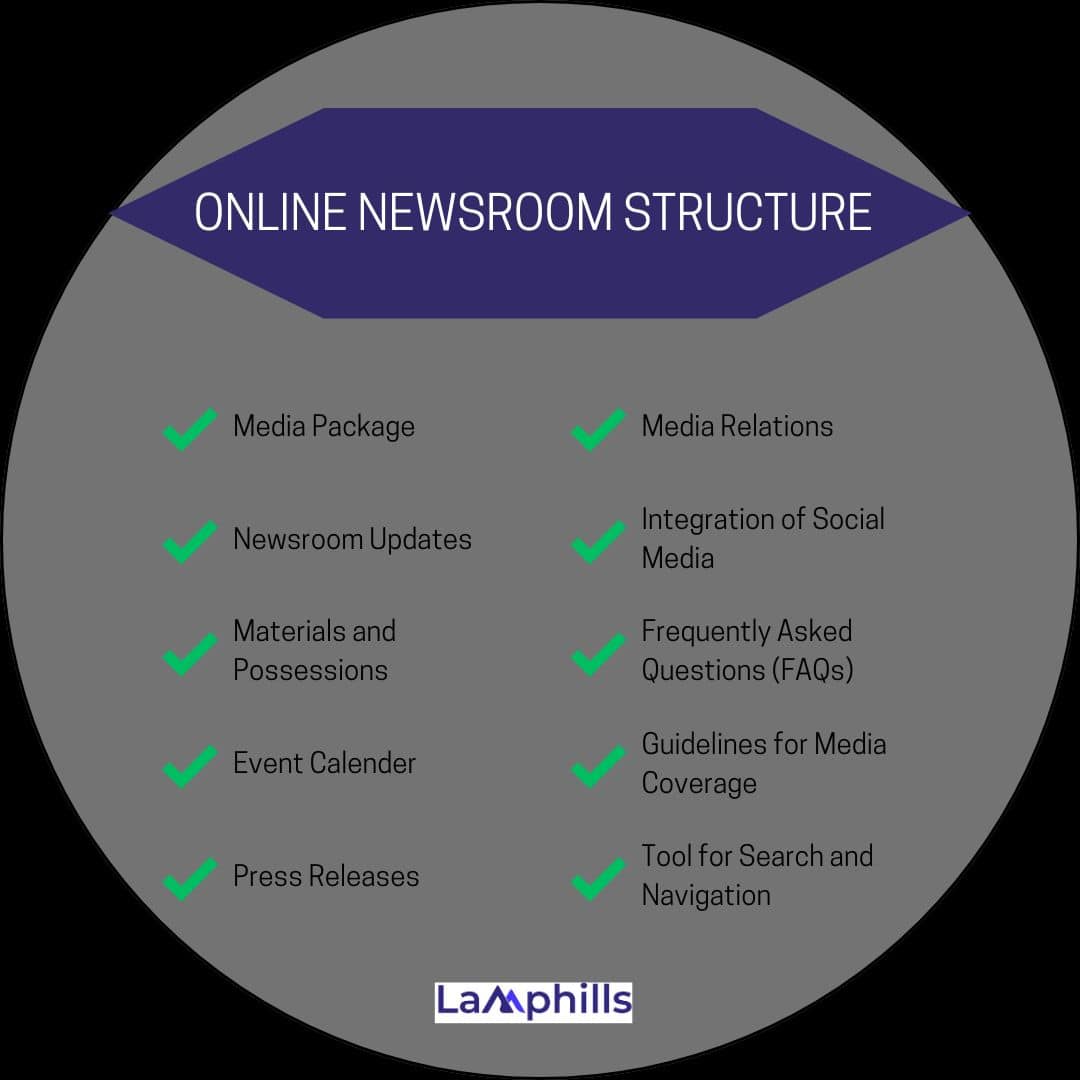Having an online newsroom for your business is the best way to make your brand and name known and effective in a competitive industry. Sharing your news with the media is no longer the only way marketers use internet content to engage their audience and gain credibility. An online newsroom, or digital media center, is often known as an online newsroom. However, a dedicated section of a company’s or organization’s website is a central location for sharing news, information, and press releases with stakeholders, media professionals, and the media at large. Enabling easy access to relevant and up-to-date company information is the primary objective of an online newsroom, which also helps with media relations and efficient communication.
Key Points
- A newsroom is where the editorial departments of newspapers, radio stations, TV stations, and multimedia enterprises communicate with one another.
- Online newsroom software gives businesses a branded webpage so they can host and distribute media or news on one platform. The most robust digital newsroom software is available to assist organizations of all sizes in conveying their stories to the audiences of their choice.
- To satisfy a company’s specific requirements and achieve its KPIs, an online newsroom or content platform must be created.
- A well-functioning online newsroom not only helps journalists find out about the organization and its latest news but also helps the newsroom manage its public image, improve transparency, and cultivate good media relations.
- For material to be arranged and presented in a clear, approachable, and user-friendly way in an online newsroom, the structure is crucial for journalists, stakeholders, and members of the public
What is an Online Newsroom?
The newsroom definition has the following context for journalism: One is the editorial desk, where news articles, reports, and themes of the day are received. Furthermore, the newsroom, also known as the newsdesk, serves as a gathering place for senior editors from all departments to deliberate on various subjects and organize the dissemination of related content across various media. With the aid of appropriate newsroom tools, this can be done digitally in a newsroom or by a person at a physical desk.
A press release section on your website serves as a central location for all company news and press releases and is called an online newsroom, often called an online press room. You have total control over the story you tell and what information is made public in an online press room. If you want to know what your business has been up to, it’s also the place to go for influencers, journalists, former and current clients, and even staff members. A lot of online newsrooms offer press kits and releases, images, logos, audio, video, executive biographies, contact details, events, company background, and accolades.
Additionally, industry news streams are occasionally included. Businesses are consolidating their social media presence into their online newsrooms on a growing scale. A few newsrooms have interactive forums where representatives from the organization, angry customers, and product evangelists may have continuous online discussions about the company, its services, and its ideology. To satisfy a company’s specific requirements and achieve its KPIs, an online newsroom or content platform must be created. The most robust digital newsroom software is available to assist organizations of all sizes in conveying their stories to the audiences of their choice.
Online Newsroom Software
Online newsroom software gives businesses a branded webpage so they can host and distribute media or news on one platform. A newsroom is where the editorial departments of newspapers, radio stations, TV stations, and multimedia enterprises communicate with one another. The online newsroom has the following best software, which I will list below:
#1. PR.co
PR.co creates tools and elegantly designed online newsrooms to assist PR teams in raising brand recognition, gaining media attention, and cultivating a favorable image. Their online newsrooms help all stakeholders, from journalists to investors, easily connect with your brand and highlight the significant achievements of your firm.
#2. Prowly
Prowly is a comprehensive tool for managing public relations that empowers professionals who are focused on growth to secure media attention by utilizing cutting-edge technology, personalized storytelling, and inventive storytelling. By developing successful plans based on industry data, users may build lasting connections with journalists. They can also demonstrate their value to customers and stakeholders by providing clear and concise observations.
#3. The Accesswire
Communications professionals can operate more simply and effectively on a daily basis with the help of the Accesswire online distribution platform. As a journalist today, communications professionals just need to rely on one resource to organize their events, create a newsroom, and disseminate press releases—all with the touch of a button.
#4. Presspage
A platform designed for continuous PR teams that handle publishing, distribution, and media relations. Presspage uses digital newsroom tools to publish and distribute your most critical messages more quickly, accelerating your communications program. Corporate communications teams can be proactive in a reactive environment with their online PR newsroom software. However, it comes with digital newsroom tools, a database with media contacts, a distribution suite, and a media relations center.
Online Newsroom Structure
A well-functioning online newsroom not only helps journalists find out about the organization and its latest news but also helps the newsroom manage its public image, improve transparency, and cultivate good media relations. Organizations might improve their communication efforts by keeping a well-structured and educational online newsroom. An online or digital newsroom is a page on your business website that compiles all of your media materials into one continuous content stream, such as press releases.
News about brands. Number sheets, facts, and statistics. similar articles from your sector. For material to be arranged and presented in a clear, approachable, and user-friendly way in an online newsroom, the structure is crucial. Journalists, stakeholders, and members of the public may all locate pertinent news releases, media outlets, and organization information with ease if an online newsroom is well-organized. An efficient online newsroom often has the following structure, which I will list below:
#1. Media Package
A downloadable press kit or media kit that includes a wealth of information about the company, such as executive biographies, background information, high-resolution photos, videos, and important statistics. Every company with an online newsroom outlet should have its own media package.
#2. Newsroom Updates
A stream or repository of current news stories, editorials, and press reports on the company. This could contain references to outside news outlets that report on the business. The company’s online newsroom should have current updates related to it.
#3. Materials and Possessions
As a journalist in a company, the company should have possession of extra materials and multimedia materials, i.e., data visualizations, company reports, audio files, and video clips for use in media.
#4. Event Calendar
As a journalist in an online newsroom company, any event happening around you should be able to provide information for publications. For example, details on forthcoming press conferences, webinars, trade exhibitions, and speeches that the organization is hosting or attending.
#5. Press Releases
A section with the organization’s press releases, news updates, and official announcements. Press releases address a variety of subjects, including new product introductions, business gatherings, collaborations, accomplishments, and noteworthy advancements. As a journalist in an online newsroom company, you should cooperate with your crew to achieve success.
#6. Media Relations
As a journalist, you should have the communicative spirit and tools to advance. Contact details for requests for interviews and media inquiries, such as phone numbers, email addresses, etc. This facilitates communication between reporters and journalists and the relevant media relations team or spokesperson.
#7. Integration of Social Media
Create links that lead to the official social media profiles of the organization, allowing users to interact and follow on different social media sites. In any event, as a journalist, you can make it easy for your audience by creating links to the event online
#8. Frequently Asked Questions (FAQs)
Responds to frequently asked questions concerning the company, its services and goods, its role in the industry, and its media relations practices from both the public and journalists. As a journalist, you research to know more to be able to respond to your audience if any question arises.
#9. Guidelines for Media Coverage
Information about embargo conditions, interview procedures, and usage rights for logos and photos are among the guidelines provided to journalists and other media professionals covering the organization. As a journalist, you should know every detail of the company, including its background, mission, vision, product, and how to use it for publication with the target audience.
#10. Tool for Search and Navigation
Your company should have friendly search options, filters, and navigation to make it easy for users to locate particular newsroom articles or interesting subjects. As a journalist working for a company’s online newsroom, you should create tools for an easy view of the company for your target audience.

Online Newsroom Example
A single page that houses all of your company’s news and press releases is called an online newsroom or press room. You can control the platform and share updates while managing your story. Customers, workers, influencers, and journalists can all use it as a resource. The following examples of online newsroom tools are useful, which I am listing below:
#1. Mapbox
Developers and designers can acquire tools, like SDKs and APIs, from this mapping and location cloud platform. Their newsroom website exemplifies a strong online press room. It is thorough, powerful, and well-designed.
#2. Impraise
Impraise is a people-enablement platform made for HR departments looking to boost worker productivity via goal-setting, frequent check-ins, and feedback cultures. For journalists, this means a much easier job because every asset is ready to use and can be downloaded. By using this software, you can reach your target audience easily.
#3. Squarespace
Among other things, Squarespace is an all-in-one website management platform that simplifies the process of creating websites, registering unique domain names, and doing performance analyses on the sites.
Everything began in 2005 when, as a writer with a recent graduate degree in mass communication and a journalist, I felt thrilled to enter the busy internet newsroom for the first time under the name Business Yield Presspage online newsroom. The workspace was modern and equipped with computers, as well as authors, editors, and journalists who collaborated to make the company successful. There was collaboration in the verification of information and discussions over the most recent news. Even though everything was in disarray, there were tales ready to be told in this work of action.
My initial task was to research breaking news on the most recent cases of human trafficking. I was a little anxious because it was my first time. My editor provided a file for me to gather the information, check it, and post it online within one hour. I got right to work, hunting for reliable sources, mining social media for clues, and double-checking every detail. Although it was difficult, I managed to do the task in less than an hour, and my editor quickly reviewed and published it. After the story was published, shares and comments began to come in shortly. The feedback on my work pleased me.
As the days passed, I picked up the skills necessary to modify my work using the fundamentals of web technology. Social networking platforms, analytics dashboards, and content management systems are among the tools of the trade that he swiftly picked up. Learning the ins and outs of each tool was like taking a new course.
Read Also: Monitoring Online Content: How To Do This In 5 Steps
Using Mapbox to monitor reader engagement was one of my key tools. I might adjust the content strategy by looking at which stories connected with the audience. Understanding the readers was just as important as simply relaying the news. I found that the public was hungry for in-depth investigative reports and tales of human interest. With this information at hand, I had to change my emphasis and produce more of what the readers enjoyed, which increased interaction and led to favorable comments that helped me advance. In addition, I had to deal with difficult tasks involving the collapse of a structure in a distant riverine area. I had to report on the incident’s cause, how the building collapsed, etc. It took me time because there were injured people who needed to be sent to the hospital right away.
There were a lot of different journalists there, and while gathering quality information was important, it was also vital to convey the facts objectively. I coordinated with rescue crews, conducted interviews with survivors, and documented the unfiltered feelings of those impacted. The knowledge that the reporting contributed to the mobilization of relief and support made the fatigue and emotional toll worthwhile. More than just a place of employment, the online newsroom is an evolving environment where people and stories come to life, technology, and humanity collide, and every click, share, and comment adds to the continuous story of our world.
Read Also: Media Training Tactics for Business Success: Elevate Your Communication Skills for Unbeatable Presence
I did it in collaboration with my team, the editors, and other community members, garnering recognition and igniting a conversation about responsibility and transparency. The digital newsroom is always changing. Reader tastes vary, new platforms appear, and algorithms evolve. There are opportunities as well as challenges in adjusting to these developments.
I am now adaptable and welcome new resources and approaches. The use of multimedia storytelling was one noteworthy adaptation. I started adding more podcasts, interactive components, and films to the narratives. In addition to drawing in a larger audience, this strategy improved the storytelling process. The real-time analytics showed how readers interacted with these aspects, and it was quite satisfying. Although it wasn’t easy at first, I am now becoming more and more proficient in the newsroom as a result of his daily reading and research.
In the competitive marketplace, using any of these tool examples helps a business grow quickly and without delay, drawing clients in the process. As the days passed, I was able to use my digital skills properly. There was an event I had to cover for the company, so I had to use the best tools to get a good result. So I used the Slack tool for proper communication and file sharing, the collaboration tool (Google Docs) for cooperation, SEMrush for tracking website traffic, SEO, keyword research, competitive analysis, etc., and also used Canto for storing and ScribbleLive for sharing the content online to reach a larger audience. If you use these tools in your online newsroom as a journalist, I assure you that you will achieve greater success.
What are the benefits of an online newsroom?
Online newsrooms have several advantages that are self-evident. The following are the benefits I am listing for having an online newsroom for your business:
#1. You may win over your audience’s trust by using an online press room
Being intended for a wider audience than only journalists is one advantage of the online newsroom. Consumers, investors, and staff members all research your business in press rooms. As a journalist, to reach your target audience, you have to go online to win their trust by posting accurate information.
#2. You may attract online media and increase brand awareness by having an online newsroom
The business’s newsroom can help you attract media attention and boost brand recognition at the same time. By keeping your online newsroom current, you can easily highlight your achievements and personal development to the public. As a journalist, putting reliable content, like the company product, etc., online attracts the audience and other journalists.
#3. Time and money can be saved by having a company newsroom
Always remember to evaluate and assess the influence of your material. Keep an eye on your visits and interactions, track how they perform on social media, and ensure that you never stop getting better. Journalists, editors, and other interested parties can promptly receive all required press materials from you. When it comes to handling media relations, this saves you a ton of time. It is best for your company to have an online newsroom and a journalist to reach the target audience.
#4. You get greater web traffic and interaction with an online newsroom
One advantage of having an online newsroom is that, with proper search engine optimization, it can increase traffic from the newsroom to your firm’s website. Optimized press materials can help you reach more people and attract journalists searching for topics, subjects, and activities to report on. As a journalist, posting accurate and reliable things online helps you reach your target audience easily.
Why you should have an online newsroom for your company
These are a few justifications I made for why your company requires an online newsroom.
#1. Moderated Text Messages
You have greater influence over your messaging when you use an online newsroom. You may make certain that journalists are provided with precise and current information regarding your projects, milestones, services, and goods. By doing this, you may reduce the possibility of false information spreading about your brand and help to create its story. For example, with the use of private sources, as a journalist, I can get accurate information for my target audience.
#2. SEO Advantages
Moreover, an online newsroom will help your search engine optimization (SEO) campaigns. You may improve your website’s visibility in search engine results by adding fresh content to your newsroom on a regular basis, such as blog entries and press releases. Your website may receive more organic traffic as a result, enhancing your online visibility in general. As a journalist, you should know how to optimize for good reading and viewing for your audience.
#3. Media Availability
Journalists must have rapid access to reliable information because they frequently operate under pressure. You may save them a great deal of time and work by offering an online newsroom where they can easily locate the most recent press releases, media assets, and contact details for press inquiries. As a journalist, to reach your target audience, you have to know how to use the tech media to send information, for example, data analysis, Twitter, other social sites, etc.
#4. Crisis Intervention
An online newsroom may serve as an invaluable resource for crisis management and bad press management. Utilizing it will allow you to promptly respond to inquiries, inform the public and media, and supply resources. By taking preventative action, you may lessen reputational harm and preserve consumer confidence in your company.
#5. Credibility and Brand Image
An online newsroom showcases your dedication to professionalism and openness. A clean newsroom improves the perception of your company among journalists and the general public. It demonstrates how transparent, well-organized, and proactive your company is in its communications.
#6. Relationships with Investors
Investors and stakeholders can be catered to by an online newsroom in addition to the media. You can show transparency and promote engagement with the investing community by making financial statements, conference calls, and various investor-related documents accessible.
What is the purpose of a newsroom?
A newsroom is an area within a newspaper, radio station, or television network where stories and news are produced for publication or broadcast. The gathering, writing, editing, and assembly of stories for a newspaper, TV, or news broadcast takes place in the newsroom.
What to include in an online newsroom?
The following are the elements that I am listing for your online newsroom that are essential to helping you set the standard:
- Knowledgeable database.
- Information about the company.
- Multimedia.
- Logos of brands.
- Business standard boilerplate.
- Executive descriptions.
- Images.
- Local newsrooms.
- Media kits.
- Media.
- Contacts.
- Social Links.
- Events.
- Press releases.
- Search.
- Analytics.
Conclusion
By understanding the idea behind an online newsroom, you can implement this technique in your company and see rapid growth. Transparency, ease of media contact, and expediency in the dissemination of news and information to external stakeholders are the main objectives of an online newsroom. Organizations may engage with the media, manage their public image, and guarantee accurate and fast information transmission by keeping an up-to-date and well-organized online newsroom.
Now that you know exactly what an online newsroom does and why, it should be much simpler for you to get started with setting up your own for your business.
Related Articles
- How to Become a Journalist Even Without Experience: An Insider’s Guide
- Crafting the Perfect Journalism Resume: Tips for Standing Out in a Competitive Field
- How To Send a Press Release: Your Personal Guide to Making Waves in the Media
- THE ULTIMATE GUIDE TO OWNED MEDIA: Best Strategies & Examples
- 29 Best PR Software for PR Professionals (Detailed)






